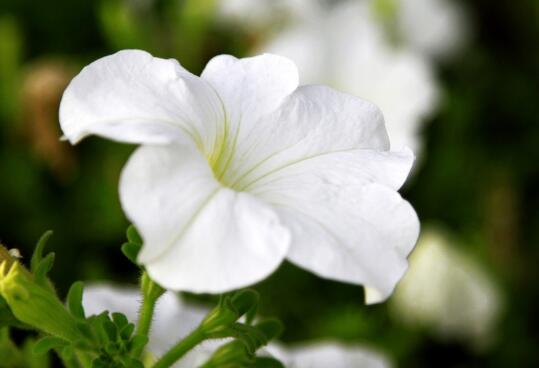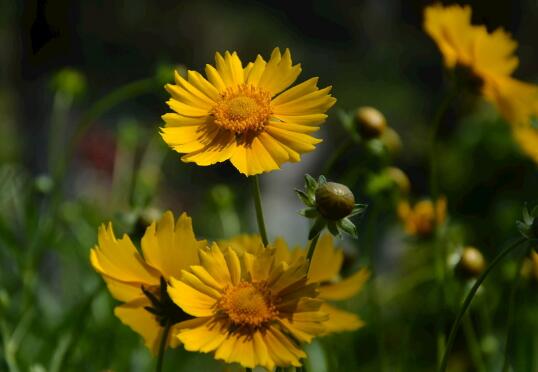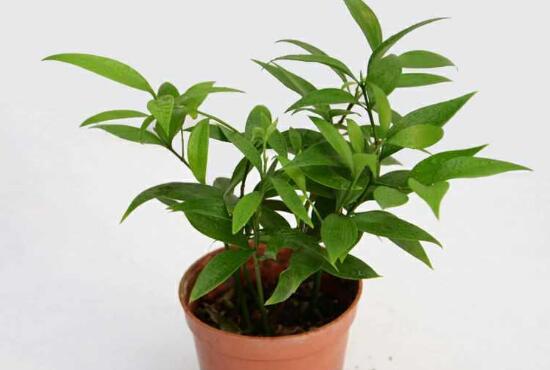What should we do when the moonlight flower grows insects? disease and pest control of the moonlight flower / 2 insect pests 2 diseases
After we cultivate moonlight flowers, the last thing we want to encounter is diseases and insect pests. This kind of problem is very harmful to the plant, which will not only affect the beauty of the plant type, but also cause the plant to die seriously, so what should we do if the moonlight flower grows? How to prevent and control diseases and insect pests of moonlight flowers? Next, the editor will take you to learn about it.
First, the moonlight flower grows worm how to do, look for the reason

If you want to know what to do when the moonlight flower grows, we must first understand what kind of insect is growing, so that we can carry out targeted treatment, because the treatment methods of each kind of diseases and insect pests are different, we have to according to the actual situation, the details are introduced below, let's take a look.
Second, disease and pest control of moonlight flower (pest)
1. Aphids
Aphids are extremely harmful to more than 250 species of plants. Moonflower is one of them. The volume of this pest varies from 1 to 10mm. It mainly absorbs the sap of the plant, which makes the plant lose a lot of nutrients and die gradually.
Control method: when we deal with this moonlight pest, we can directly use 40% imidacloprid water solvent 1500-2000 times or 50% aldicarb 3000 times to directly spray it.
two。 Longicorn beetle
Longicorn beetles are the general name of polyphagous suborder Cerambycidae insects. The harm of longicorn beetles to moonlight flowers is the strongest in the larval stage, and the larvae will gradually look at the plants, thus hindering the normal growth of the plants, reducing the yield, weakening the tree potential, shortening the life span, and causing the plants to wither and die quickly when the damage is serious.
Control method: for this moonlight pest, we can use 80% dichlorvos EC to inject into the injured punch, and then seal the punch with yellow mud to kill the pest at once.
3. Disease and pest control of moonlight flower (disease)
1. Powdery mildew
Powdery mildew is a disease with high incidence of moonlight. This disease mainly threatens the leaves of plants. When the disease occurs, there will be many dust-like mildew spots on the leaves, which will cause the leaves to turn green at the initial stage, and in serious cases, the whole leaves will be covered with powdery mildew layer. As a result, the plant can not carry out photosynthesis and gradually atrophied.
Control methods: in the prevention and control of this moonlight flower diseases and insect pests, we can use 1000 times of methyl topiramate wettable powder to spray the plant, usually once every 10 days, about 2-3 times can be cured.
two。 Leaf spot disease
Leaf spot disease, through its name, we know that it is harmful to plant leaves, when the disease occurs, there will be many irregular disease spots on the leaves of Yueguanhua, and small black spots will appear on the disease spots over time, which will affect the ornamental quality very much.
Control method: when we deal with this moonlight disease and insect pest, we can use 50% carbendazim wet powder 500 times to spray the diseased plant, generally spray once every 7-10 days, and then recover after 3-4 times.
What to do when the sea immortal grows insects? pest control of sea immortal / 2 insect pests 2 diseases
When we cultivate sea immortal flowers, the last thing we want to encounter is diseases and insect pests, this kind of problem is very harmful to the plant, which will not only affect its ornamental value, but also cause the plant to die gradually. So what should I do if the sea immortal has grown worms? How to control the diseases and insect pests of sea immortals? Next, the editor will take you to learn about it.
First, how to do the sea immortal flowers with worms? find the reason.
If you want to know what to do with sea immortal worms, first of all, we have to understand what kind of insects they grow, so that we can deal with them pertinently, because the treatment methods of each kind of diseases and insect pests are different, and the details are introduced below. Friends who are troubled in this respect can learn about it.
Second, pest control of sea immortal flowers, 2 insect pests and 2 diseases
1. Shell worm
Scale insect is a kind of pest with high incidence in the growth process of sea immortal. it mainly threatens the leaves, branches and fruits of sea immortals, resulting in its leaves gradually yellowing and falling off, and finally the whole sea immortals will gradually wither.
Control method: when we deal with the diseases and insect pests of this kind of sea immortal, we can directly use 1000 times of omethoate emulsion to spray it, the effect is very good.
two。 Longicorn beetle
Longicorn beetles are the general name of the polyphagous suborder Cerambycidae insects. The harm to the sea immortal flower is the strongest in the larval stage, and the larvae will gradually look at the plant, thus hindering the normal growth of the plant, reducing the yield, weakening the tree potential and shortening the lifespan. When the damage is serious, it will also cause the plant to wither and die quickly.
Control method: for this kind of sea immortal disease and insect pest, we can use 80% dichlorvos EC to inject into the injured punch, and then seal the punch with yellow mud to kill the pest at once.
3. Leaf spot disease
Leaf spot is a disease that may occur in many plants, and sea immortals are no exception. During the disease, many brown spots will appear on the leaves of the plant, and will gradually spread, resulting in the gradual drying up and death of the plant.
Control methods: for this kind of sea immortal diseases and insect pests, we can use 38% cuproloxil 800-1000 times or 80% mancozeb 400-1000 times to spray the diseased plants, usually once every 10-15 days, 1-2 times.
4. Rust disease
Rust is a disease that occurs in many plants, and sea immortals are no exception. This disease mainly threatens the leaves, stems and fruits of plants. When the disease occurs, many blister spots will appear in the affected parts, and when serious, the blister spots will be dense and the plants will die quickly as a result.
Control method: in the prevention and control of this kind of sea immortal diseases and insect pests, we can use 20% verapamil EC 400 Mel 600 times liquid spray to spray sea immortal flowers, usually about 15 days once, 2-3 times later can be cured.
What to do when tennis flowers grow worms? pest control of tennis flowers / 2 insect pests 2 diseases
In the process of cultivating tennis flowers, the last thing we want to encounter is diseases and insect pests, this kind of problem is very harmful to the plant, which will not only affect the beauty of the plant type, but also lead to plant death. So what should I do if there is a bug in tennis? How to prevent and control diseases and insect pests of tennis flowers? Next, the editor will take you to learn about it.
First, what if the tennis flower grows worms? find the reason.
If you want to know what to do with tennis flower bugs, first of all, we have to understand what kind of insects grow, so that we can deal with them pertinently, because the treatment methods of each kind of diseases and insect pests are different, and the details are described in detail below. Friends who are troubled in this respect can learn about it.
II. Pest control of tennis flowers (pests)
Slug
Slug, also known as Snotlout, is a mollusk that looks like a snail without a protective shell. It mainly threatens the leaves of tennis flowers and gradually erodes them, resulting in a lot of wormholes in their leaves. Very beautiful.
Prevention and control methods: when we deal with this kind of tennis flower diseases and insect pests, we can make use of its habit of climbing out and feeding activities after watering, after rain, early morning, evening, and cloudy days.
Root nematode
Root nematode is a highly specialized omnivorous plant pathogen nematode, it is very harmful to the plant, at the beginning of the leaf will appear many red spots, and with the passage of time will cause the leaf to fall off gradually, the plant will gradually dry up.
Control methods: when we deal with root nematodes, which are diseases and insect pests of tennis flowers, we can use 10 grams of line phosphorus or 5% Yishubao to treat the plants. generally, we can use the medicine once every 5-7 days, and the pest can be thoroughly understood 2-3 times.
III. Pest control of tennis flowers (diseases)
Rust disease
Rust is a relatively high incidence of diseases and insect pests of tennis flowers. This disease mainly threatens the leaves, stems and fruits of plants. When the disease occurs, many blister spots will appear in the affected parts, and when serious, the blister spots will be dense and the plants will die quickly as a result.
Prevention and cure: when rust occurs on tennis flowers, we can spray it with 2000 times of 50% verapamil wettable powder, which is usually sprayed once every 7-10 days and can be cured once or twice.
Powdery mildew
Powdery mildew is a disease caused by powdery mildew infection. Many white dust-like disease spots appear on the leaves of tennis flowers at the time of the disease, and gradually cover the whole leaf surface over time. As a result, the plant is unable to carry out photosynthesis and gradually shrinks and dies.
Prevention and treatment methods: if we find the symptoms of powdery mildew on the plant, we must deal with it as soon as possible. during the treatment, we can use triadimefon 800 times liquid spray to treat the plant, usually once every 7-8 days. Generally, it can be cured after three consecutive sprays.
- Prev

What to do with the growth of Chrysanthemum morifolium? pest control of Chrysanthemum morifolium / 2 insect pests 3 diseases
In the process of breeding golden rooster chrysanthemum, the last thing we want to encounter is diseases and insect pests, this kind of problem is very harmful to the plant, so we must deal with it as soon as we find it. What about the golden rooster chrysanthemum worm? How to control diseases and insect pests of Chrysanthemum morifolium
- Next

What to do with the growing insects of bamboo and cypress, the control of common diseases and insect pests / 3 insect pests and 3 diseases
For bamboo and cypress, flower friends should be no stranger, it is neither bamboo nor cypress, it is a beautiful foliage plant, raised by many people at home. However, in indoor breeding, due to improper maintenance, high air humidity, poor ventilation and other reasons, bamboo and cypress are easy to get sick, affecting the growth of plants. So, what about the bamboo and cypress worms?
Related
- Fuxing push coffee new agricultural production and marketing class: lack of small-scale processing plants
- Jujube rice field leisure farm deep ploughing Yilan for five years to create a space for organic food and play
- Nongyu Farm-A trial of organic papaya for brave women with advanced technology
- Four points for attention in the prevention and control of diseases and insect pests of edible fungi
- How to add nutrient solution to Edible Fungi
- Is there any good way to control edible fungus mites?
- Open Inoculation Technology of Edible Fungi
- Is there any clever way to use fertilizer for edible fungus in winter?
- What agents are used to kill the pathogens of edible fungi in the mushroom shed?
- Rapid drying of Edible Fungi

